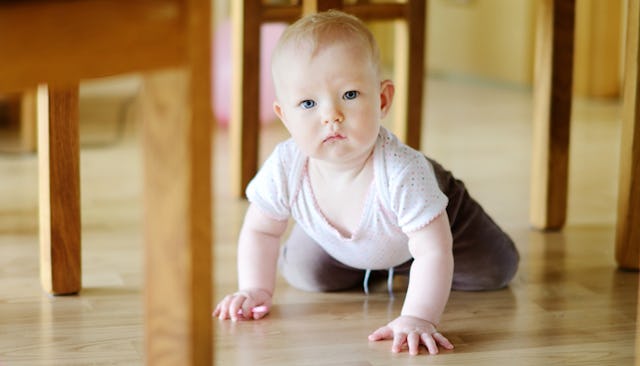So You Think That's Baby Proofed?!

They say that no two kids are alike. One child may be book smart and verbose, while another child is athletic and bold. Or you get kids like mine. My kids are mischievous little boundary pushers who are forever poking holes in my rules, my patience levels, and my diabolical plans to tether in their energy and floor space.
To highlight the varying degrees of budding escape artist talent, let’s play a little game called, So You Think That’s Baby Proofed?! The object of the game is to keep your baby alive and your house intact. Bonus points for lack of injury to feelings AND body. I’m talking about yours not the baby’s.
Ready? Here we go:
1. You put those plastic do-hickey-thingys on all the cabinet doors in the kitchen to keep little fingers from getting pinched while also protecting your stuff.
a) Your kid figures out how to break them off. MINUS 3 POINTS
b) Your kid figures out how to loosen them enough to repeatedly bang the cabinet door. MINUS 10 POINTS
c) Your kid has no interest in the cabinets for several months. You foolishly decide that this part of child proofing is a giant pain in the ass so you remove them. And THAT is when your kid discovers where the snacks are stashed AND the kitchen trash. MINUS 25 POINTS
2. You carefully placed a baby gate at the bottom AND the top of the staircase.
a) Your kid spends the day throwing stuff over the gate for you to trip on when you go up and down the stairs. MINUS 1 POINT
b) Your kid bangs on, hangs from, and throws stuff at the gate all the livelong day in an impressive effort to tear down that wall! MINUS 2 POINTS
c) Your kid figures out how to climb over the gate. You start placing furniture in front of the gate to prevent this border fleeing, but your kid climbs over that too. MINUS 250 POINTS
3. You bought those plastic doorknob handles and now you have trouble entering and exiting your own house.
a) But your kid does not and has figured out that if his tiny hands can grasp the doorknob through the gapping holes on the doorknob cover then he can open the door. Even though you cannot. MINUS 5 POINTS
b) In a moment of sheer cleverness on your part, you wrap a soft bandana around the doorknob that will slip around for your toddler, but not for you. SCORE 300 POINTS
c) Until your toddler realizes that he just has to squeeze really hard and twist to get the door open. MINUS 30 POINTS, SUCKER
4. Your child can now reach for stuff on tables and countertops.
a) So you start pushing things further from the edge. SCORE 1 POINT
b) Your child then realizes that if he holds an oblong shaped object (spatula, broom handle, stick, plastic sword…) he can effectively knock stuff off the counter and onto the floor. MINUS 10 POINTS
c) You child has a growth spurt and can scale the kitchen counter, bookcases, and move chairs around. The top of the refrigerator is now piled to the ceiling with stuff in timeout. MINUS 25 POINTS
5. Electrical outlets are now the scariest thing ever invented. So you buy those plastic button style inserts to protect little fingers from getting zapped.
a) Those plastic button covers look like fun! So your kids go around the house and within 30 seconds figure out how to remove them. MINUS 700 POINTS
b) You freak out and put them all back and then jump around wildly explaining to the kids that those are bad! Dangerous! Ouch! Their interest is now at peak level. MINUS 1000 POINTS
c) Then you remember duct tape. You cover all the outlets. The kids can’t rip the tape off. But you also can’t plug anything in either. SCORE 1.5 POINTS
Now add up all the points you lost and shake your fist in the air at how astoundingly frustrating the most basic of safety precautions for wee ones can be. Outlets, plugs, sharp objects, potential lead poisoning, pinched fingers, and choking hazards are the stuff that parental nightmares are made of. The fastest way to figure out how to baby proof a house is to get down on the floor and follow your kid around to see where all the interesting things are.
Good Luck!
Related post: 10 Things You Should Know About Babies
This article was originally published on